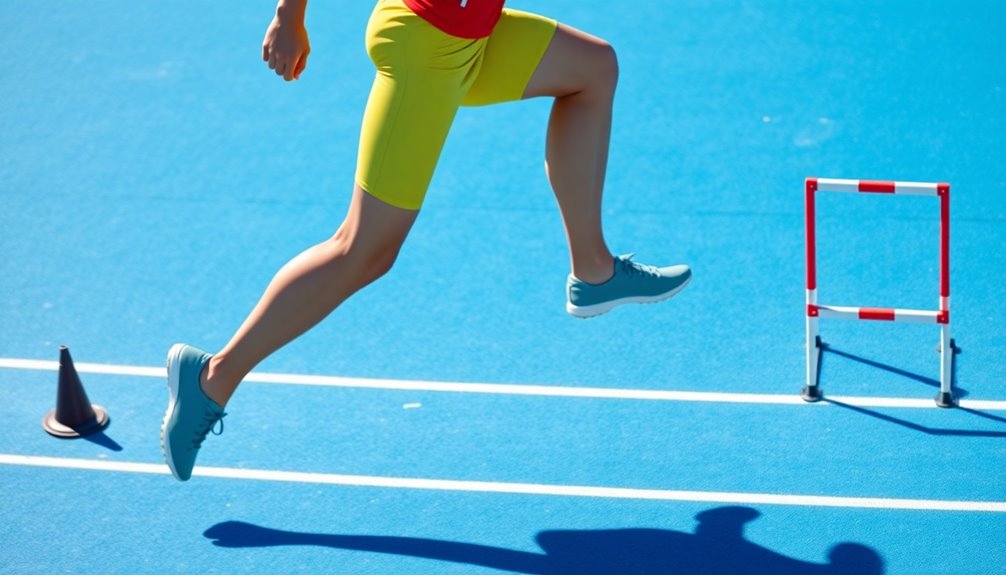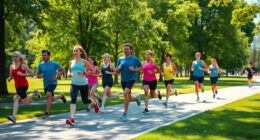Mastering your running form boosts performance and prevents injuries. Focus on proper posture—keep your feet landing beneath your center of mass, maintain an upright stance, and aim for a cadence of 170-185 steps per minute. Strengthen your core for better balance and leg movement. Incorporate drills like high knees, skip drills, and the A Walk Drill to refine your technique. Want to discover more about key drills and techniques? There's plenty more to explore!
Key Takeaways
- Focus on proper posture by keeping feet landing beneath your center of mass to prevent overstriding and improve efficiency.
- Engage your core muscles to enhance stability and promote good leg movement during runs.
- Incorporate arm swing in sync with leg movement to maintain stride balance and improve running efficiency.
- Practice drills like High Knees and the Skip Drill to enhance coordination, rhythm, and overall running mechanics.
- Regular form assessments with a professional can help identify and correct postural issues for better performance.
Importance of Running Form and Injury Prevention

When you pay attention to your running form, you not only enhance your performance but also markedly lower your risk of injury. Proper running posture is essential; your feet should ideally land beneath your center of mass to avoid overstriding.
Keeping an upright posture without leaning from your waist helps maintain a balanced knee position, reducing injury risk. Aim for a cadence of 170-185 steps per minute to improve your running mechanics and lessen muscle strain.
Additionally, minimizing pelvic drop and avoiding excessive hip hike can greatly cut injury risk, possibly by up to 17 times. Regular form assessments with a health professional can help you identify and correct any postural issues, ensuring effective injury prevention. Emotional regulation is also important in maintaining focus and resilience during your training, ultimately contributing to better performance and injury avoidance.
Core Strength, Balance, and Running Mechanics

To improve your running form, you need to engage your core muscles effectively. This engagement not only stabilizes your body but also enhances your leg movement, making each stride more efficient. Additionally, incorporating visualization techniques can help you maintain focus on your form and improve your overall performance.
Core Muscle Engagement
Engaging your core muscles is essential for maintaining proper running form, as it not only enhances posture but also minimizes the risk of injuries. A strong core promotes good posture, allowing you to lean slightly forward from your ankles, which aids in forward acceleration.
Core stability guarantees your legs move freely and efficiently, reducing the chances of overstriding and keeping your feet landing beneath your center of mass.
To boost your core engagement, incorporate drills like high knees and high hops; they improve knee range of motion and enhance push-off efficiency. Additionally, engaging your core can also improve cardiovascular fitness, which is crucial for endurance during long runs.
Balance Testing Techniques
Mastering balance is essential for optimizing your running mechanics, as it directly affects your core strength and overall stability.
One effective method of balance testing is standing on the balls of your feet. This exercise helps you assess your core stability while also identifying any imbalances. Engaging your core during this test is vital, as strong core muscles support good posture and maintain stability while running.
Additionally, practicing balance drills, like standing on one leg, enhances your proprioception and boosts running mechanics. Focus on maintaining a balanced knee position during these tests to prevent unnecessary stress on your muscles and tendons, reducing your risk of injury. Incorporating sustainable foraging into your routine will ultimately strengthen your core stability and improve your running performance.
Incorporating balance training into your routine will ultimately strengthen your core stability and improve your running performance.
Efficient Leg Movement
Achieving a balanced stance lays the groundwork for efficient leg movement during your runs. Strong core muscles support good posture, allowing your hip flexors to work effectively. Engaging your core keeps you upright, enhancing your stride's effectiveness. Drills like high knees and high hops improve your stride length and push-off efficiency, vital for speed. Additionally, understanding software development life cycle can help you incorporate structured training methods that enhance your running technique.
| Drill | Benefits | Frequency |
|---|---|---|
| High Knees | Increases knee range of motion | 3 times a week |
| High Hops | Enhances flight phase | 2 times a week |
| Cadence Drills | Boosts step rate | Daily |
Aim for a cadence of 170-185 steps per minute to maximize running efficiency and reduce injury risks.
Arm Swing and Hip Engagement

Proper arm swing and hip engagement play an important role in enhancing your running efficiency. When you drive your arms in sync with your legs, it helps maintain balance and prevents disruptions in your stride.
To monitor your arm swing, consider using labels on your running tops, ensuring you keep the correct posture and rhythm. Engaging your hips effectively allows for ideal power generation, contributing to stability during your run.
By driving your hips slightly forward, you maintain momentum and reduce the risk of overstriding, which can lead to injuries. Incorporating tyre sprints into your training emphasizes hip engagement, encouraging that vital forward push and proper arm-leg coordination during high-speed movements. Additionally, understanding risk tolerance can help you assess how much effort to exert during different training drills.
Focus on these elements to elevate your running performance.
Drills for Improving Running Form

To enhance your running form, incorporating effective warm-up drills is essential.
You'll also want to focus on core stability exercises and perfecting your arm swing techniques.
These elements work together to improve your overall efficiency and reduce the risk of injury. Additionally, understanding the importance of safety in your training regimen can further enhance your performance and well-being.
Effective Warm-Up Drills
A solid warm-up is essential for improving your running form and preparing your body for the demands of a run.
Start with the A Walk drill to coordinate your arm and leg movements, ensuring your foot placement is directly beneath you for better rhythm.
Next, progress to the A March, applying more force and maintaining proper foot placement to enhance acceleration.
Incorporate A Skips to develop core stability and arm coordination while driving your knees high.
Finally, include high knees in your routine—they're great for warming up and refining your technique. Regular warm-ups can also help prevent common issues such as toilet running issues that may arise from improper body mechanics during exercise.
These drills not only elevate your heart rate but also help you drive your knees high and keep your feet positioned correctly, setting you up for a more efficient run.
Core Stability Exercises
Warming up prepares your body for running, but maintaining core stability during your runs is what truly elevates your performance. A strong core enhances your posture and stability, improving your running efficiency and reducing injury risk. Additionally, cognitive decline can affect physical performance, making core stability even more crucial for maintaining optimal running form.
Here are three core stability exercises to help you improve your running:
- Squats: Strengthen your quadriceps, controlling impact shock on landing.
- High Knees Drills: Increase knee range of motion during the swing phase for better leg movement.
- Balance Exercises: Stand on the balls of your feet to boost core stability and promote efficient leg movement.
Incorporating these drills into your routine will markedly enhance your core stability, ultimately helping you improve your running and reach your performance goals.
Arm Swing Techniques
Effective arm swing techniques are essential for improving your running form and overall efficiency. Your arm swing should coordinate with your leg movement, driving the opposite leg forward to maintain balance.
Filming your runs can help you assess your arm swing alignment; aim for smooth, controlled motions that don't cross your midline. Engaging your core during the swing is vital, as it helps you maintain an upright posture and prevents excessive forward lean from the ankles.
Incorporate drills like Tyre Sprints to emphasize driving your hips forward while keeping a strong arm swing. You can also use labels on your running tops to remind you to maintain a 90-degree angle with your arms, ensuring they move fluidly with your legs. Additionally, focusing on your color accuracy can enhance your overall performance by ensuring that you are aware of your body positioning and movement in relation to your environment.
Training Insights and Additional Information

When you focus on mastering your running form, you'll discover that training insights can greatly enhance your performance.
Setting specific goals, like Eilish McColgan's targets for 2025, can help keep you motivated and on track.
Additionally, exploring various training methods, such as ultramarathon walking or shifting to barefoot running, can lead to better running outcomes.
Consider these key insights:
- Set Clear Goals: Define what you want to achieve in your running journey.
- Embrace New Challenges: Try unique events like Backyard Ultras for endurance training.
- Explore Techniques: Investigate minimalist running styles to improve your form and efficiency.
Incorporating these insights into your routine will help keep you focused and committed to your running aspirations.
Key Drills to Enhance Running Technique

Mastering your running technique involves incorporating key drills that can greatly elevate your performance. By focusing on specific exercises such as high knees, butt kicks, and strides, runners can enhance their form and efficiency. Understanding how to improve running speed requires dedication to these drills, as they train the body to move more fluidly and powerfully. Additionally, integrating strength training and flexibility exercises can further complement your running regimen, leading to a more productive and injury-free experience.
Start with the A Walk Drill, which helps coordinate your arm and leg movements while emphasizing foot placement directly beneath your body.
Next, try the March Drill to build on that rhythm and guarantee your feet stay positioned for better acceleration.
The Skip Drill enhances your coordination and core stability, driving your thigh while keeping your toes dorsiflexed.
High Knees serve as a warm-up and speed training exercise, focusing on compact form and effective foot placement.
Finally, incorporate High Knee Runs (DKs) to combine the high knee action with forward motion, ensuring your knees drive high while maintaining proper running form and engaging your upper body effectively.
Tips for Maintaining Optimal Running Form

Maintaining ideal running form is vital for both performance and injury prevention. Here are some tips to help you stay on track:
- Foot Placement: Make certain your feet land directly beneath your center of mass to avoid overstriding, which can strain your lower back and lead to injuries.
- Cadence: Aim for a cadence of 170-185 steps per minute; this enhances running efficiency and maintains your range of motion.
- Posture: Keep an upright posture without leaning from the waist. A forward head position can increase your injury risk by 50%.
Engaging your core during runs is essential for stability, allowing for efficient leg movement and reducing pelvic drop or hip hike issues.
Regular assessments will help you correct any postural problems.
Frequently Asked Questions
What Is the 80% Rule in Running?
The 80% Rule in running suggests you should complete 80% of your training at an easy pace. This helps build your aerobic base and improves endurance while reducing the risk of injury.
The remaining 20% can be dedicated to more intense workouts, like speed intervals or hill training.
By following this balance, you'll maintain consistency in your training, enhancing performance and minimizing burnout over time.
It's a smart strategy for long-term success.
How Do I Practice Perfect Running Form?
To practice perfect running form, start by focusing on your posture—keep it upright with a slight forward lean.
Incorporate high knees and drills like tyre sprints to improve your leg movement and stability.
Pay attention to your cadence, aiming for 170-185 steps per minute.
Regularly film yourself running to assess your form, ensuring your feet land beneath your center of mass.
Finally, practice coordination drills like the A Walk and A March to enhance rhythm.
How Often Should I Do Running Form Drills?
You should incorporate running form drills into your routine 2-3 times a week. This frequency helps reinforce proper mechanics and prevent injuries.
Aim for about 10-15 minutes of focused drills after your warm-ups or easy runs. By adding specific exercises, like high knees, during speed workouts, you'll enhance your running efficiency.
Remember to monitor your progress regularly, adjusting your drills as needed to maximize their benefits without overtraining.
How Long Does It Take to Correct a Running Form?
Correcting your running form can take anywhere from a few weeks to several months.
It largely depends on how severe your issues are and how dedicated you're to practice. If you're consistent with technique-focused drills, like high knees or tyre sprints, you might start seeing improvements in just a few weeks.
Regular assessments with a health professional can also help speed up the process by pinpointing what needs work.
Conclusion
In mastering your running form, remember that perfect practice promotes performance. By focusing on fundamental form factors like core strength and arm swing, you'll pave the path to powerful, pain-free runs. Consistent commitment to key drills will not only enhance your technique but also help you sidestep injuries. So, lace up, lean in, and let your improved form fuel your fitness journey. With dedication, you'll discover the delightful dynamics of running!









